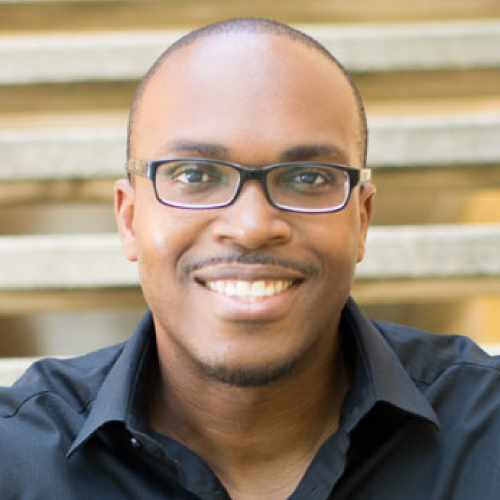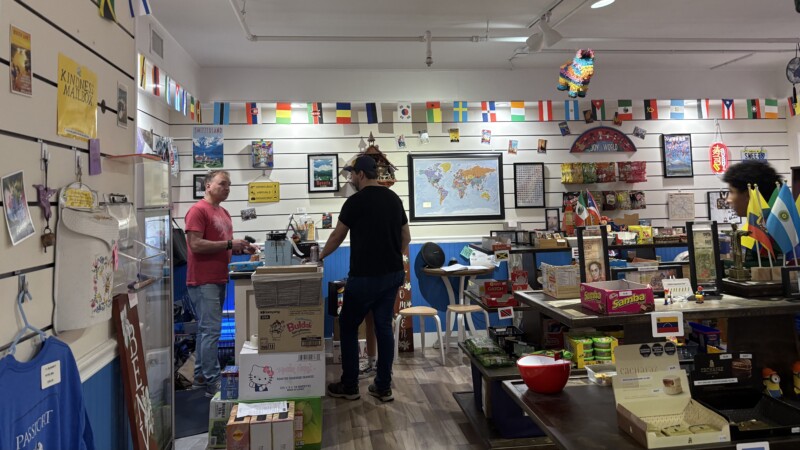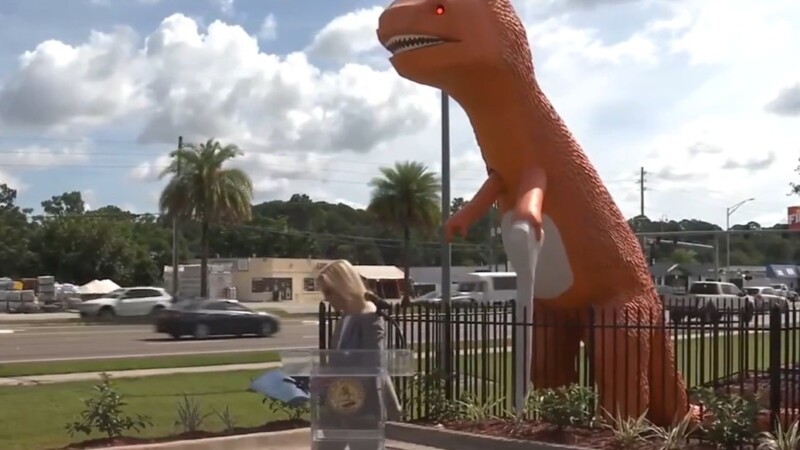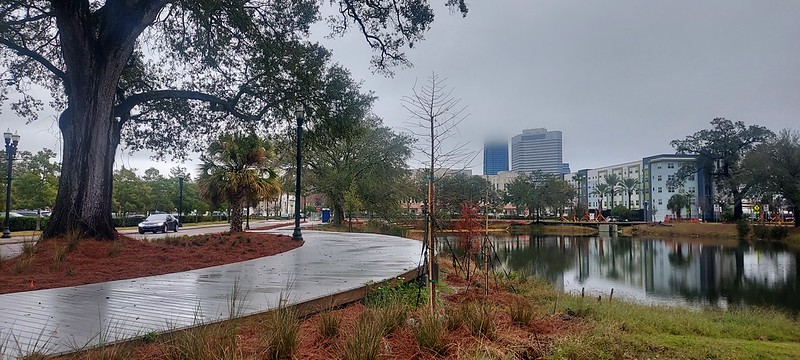
Here is a trip down memory lane, highlighting five major Jacksonville area attractions that don’t exist anymore.
1. Dixieland Park

Dixieland Park opened on March 9, 1907, in a city still recovering from financial and emotional scars of the Great Fire of 1901. Covering nearly 30 acres, Dixieland Park billed itself as “Jacksonville’s greatest resort” and “Florida’s playground.” Its advertisements promoted the finest merry-go-round outside of Coney Island, the best roller coaster south of New York, “more free attractions than any other park in the South,” and a Dixieland band, “which is the finest in the South.”
The park offered the chance to ride a 160-foot bamboo slide called the “Dixie Dewdrop,” along with a figure-eight ride, a toboggan, a laughing gallery, a “House of Troubles,” and its large merry-go-round called The Flying Jenny, which boasted 56 wooden animals. Babe Ruth once played baseball at Dixieland, and the famous bandleader John Philip Sousa once gave a concert there. Many movie companies filmed their silent flicks there also. These included jungle films, which brought elephants, tigers, camels, and horses to the park. Alligators, dog-and-pony shows, lion wrestling, hot air balloons, parachute jumps, comedy acrobats, high-wire performers, and Vaudeville acts were also featured. Visitors could refresh themselves at a swimming pool or the bathing beaches. There was even an electric water fountain. Despite its 10 cent admission fee, Dixieland Park had closed its doors by the time the country entered World War I in 1917.
Now, all that’s left of the venue which called itself The Coney Island of the South is Treaty Oak Park on the Southbank. The majestic tree that’s now nestled among retail and office buildings and high-rise condos was once part of Dixieland Park.
2. Jacksonville Beach Boardwalk

Dating back to the late 19th century, Jacksonville Beach’s boardwalk entertained generations of Jaxsons. Major attractions along the boardwalk included the Ocean View Pavilion amusement park and Playland Park. The Ocean View Pavilion was established by W.H. Adams in 1925. Its main attraction was a 93-foot-high coaster, with cars reaching up to 50 mph. Unfortunately, due to its size and being so close to the beach, the “Beach Coaster” was extremely vulnerable to damage. Eventually deemed unsafe, the coaster was destroyed in 1949 and replaced by a smaller coaster called The Wild Mouse. Business declined with the loss of the huge, distinctive coaster. Eventually a fire put an end to Ocean View during the 1950s. Located a few blocks north of the Ocean View Pavilion, Playland Park’s attractions included a ferris wheel, bumper cars, and a penny arcade with pinball machines and arcade-style games. In 1964 much of this scene was destroyed by Hurricane Dora. While the old boardwalk is gone, the SeaWalk is a remnant of the boardwalk’s golden era.
3. The Ocean Street Market

Prior to World War II, the foot of Ocean Street was Downtown Jacksonville’s answer to the type of interactive riverfront tourists seek when visiting cities like Seattle, San Francisco and Philadelphia. Located along the Northbank, the large open air seafood market sprang up following the Great Fire of 1901’s destruction of the city’s indoor public market. Soon, most of Ocean Street, south of Bay Street, was lined with produce, meat, dry goods, seafood vendors and restaurants.
For decades, it was an authentic scene where one could experience local cuisine and the area’s cultural diversity. At its height, the working waterfront included an ice manufacturing plant and crabmeat processing factory and railroad tracks serving nearby wharves and industries along the riverfront. Known for having a stench of fish, the Ocean Street Market declined after World War II due to aging infrastructure and the disbursement of the city’s population base. Determined to clean up the city’s blighted waterfront, Mayor Haydon Burns proposed an urban revitalization plan that would replace Downtown’s market and working waterfront with parking lots. By 1956, the place where Jaxsons had come to purchase their fresh catch had become one of the most scenic surface parking lots in the South.

4. Oriental Gardens

What became known as Oriental Gardens dates back to 1925, when real estate developer George W. Clark began planting overflow from his Riverside property’s botanical collection on a vacant bluff overlooking the St. Johns River near the present day intersection of Hendricks Avenue and the northern terminus of San Jose Boulevard. A former mortician, Clark was the president of the Clark Real Estate Co. and Panama Investment Co. and the developer of North Springfield and Panama Park, financially benefiting from the rebuilding of the city after the Great Fire of 1901.
After 13 years of maintaining the grounds as a private estate, Clark opened his botanical gardens to the public in 1937. Described as a “sunken garden” surrounded by groves of stately Southern pines, the 18-acre Oriental Gardens featured specimens of live oak trees ranging in age from 500 to 1,000 years, along with 100 varieties of tropical and subtropical plants, shrubs and trees. Other features included hourly concerts, citrus groves with orange, grapefruit, limes and kumquats, and Asian-themed gates, bridges, bird houses, and lighting.
At its height, Oriental Gardens was viewed as a major Jacksonville attraction and a rival of major Central Florida tourism hot spots like Cypress Gardens, Silver Springs and Bok Tower Gardens. Oriental Gardens closed in 1954 when the property was sold to the State Investment Co. during the rapid suburbanization of Duval County. Owned by real estate firm Stockton, Whatley and Davin, State carved the estate into 33 single-family home lots. Seventy years after its demise, pines, palms and remnants of the former attraction can still be found in and around the residential subdivision that replaced it.
5. Riverview Amusement Park

Between 1910 and 1920, Dr. E. H. Armstrong created the Riverview Tropical Gardens along the Trout River, just north of Lem Turner Road in the Riverview neighborhood. Formerly the location of Armstrong’s riverfront residence, the Riverview Tropical Gardens became a 25-acre fishing, boating and bathing destination known for its garden trails, native and imported trees surrounded by blooming lilies, azaleas, and roses. A local showplace after the Great Depression, the park attracted more than15,000 visitors in 1936.
By the 1950s, it had become Sid Walker’s Riverview Amusement Park, featuring a roller rink called Skate-O-Rama, 10 rides, restaurants, a swimming pool, beach, ballroom, and picnic areas. In 1959, a large portion of the site was carved out for the construction of a shopping center that was anchored by KMart for a number of years. After 51 years in operation, KMart closed its Riverview location in May 2010. In September 2011, the former store was replaced by a Roses Discount Store. While the amusement park’s rides, restaurants, pool and other amenities are long gone, the wooded area along the Trout River remains one of the most secluded and pristine public green spaces in Jacksonville’s urban core.







